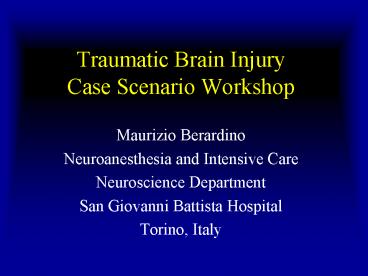Traumatic Brain Injury Case Scenario Workshop - PowerPoint PPT Presentation
1 / 23
Title:
Traumatic Brain Injury Case Scenario Workshop
Description:
Case Scenario Workshop Maurizio Berardino Neuroanesthesia and Intensive Care Neuroscience Department San Giovanni Battista Hospital Torino, Italy Overview Initial ... – PowerPoint PPT presentation
Number of Views:355
Avg rating:3.0/5.0
Title: Traumatic Brain Injury Case Scenario Workshop
1
Traumatic Brain InjuryCase Scenario Workshop
- Maurizio Berardino
- Neuroanesthesia and Intensive Care
- Neuroscience Department
- San Giovanni Battista Hospital
- Torino, Italy
2
Overview
- Initial assessment
- ABCs
- Neurologic evaluation
- Treatment
- Transport
- Neurologic Deterioration
3
Case Presentation
- 21 year old male
- Unrestrained driver, single vehicle MVC
- 70 KPH, sedan vs. concrete barrier
- No airbag
- Windshield starred
4
Primary Survey
- The patient had a clear airway and was speaking
spontaneously - Bilateral breath sounds
- A strong radial pulse at 100
- BP 120/80
5
Primary Survey
- A 3x5 cm hematoma / contusion on the patients
left superior forehead / frontal area - The patient was found walking near the accident
scene alert but confused - PERRL 3 mm
- What is his GCS score?
6
Glasgow Coma Scale
Full verbal score (5) is assigned for crying
after stimulation in children lt 2yrs.
7
Priorities ?
- Assessment / Treatment
- Airway
- Breathing
- Circulation
- Cervical Spine
- Disability
- Exposure
8
Secondary Survey
- No change in A, B, C, D
- Mild bleeding left forehead
- No other injuries discovered
9
Treatment / Interventions
- Interventions
- IV
- 02 NRB FM
- Immobilization
- C spine collar
- Back board
10
Transport Issues
- Destination
- Emergency Department
- Trauma Center
- Status / Expediency
11
After the Primary Secondary Survey
- While asking the patient about the accident his
- Speech becomes inappropriate
- Eyes remain open
- Localizes to tactile stimuli
- What is his GCS Score?
- Pupils PERRL 3mm
- What is your next action?
12
Priorities ?
- Assessment / Treatment
- Airway
- Breathing
- Circulation
- Cervical Spine
- Disability
- Exposure
13
Glasgow Coma Scale
- En route, 10 minutes from destination hospital
- Eye no opening
- Motor flexion
- Verbal non-verbal
- What is his GCS score?
14
Priorities ?
- Assessment / Treatment
- Airway
- Breathing
- Circulation
- Cervical Spine
- Disability
- Exposure
15
Reassessment
- Patient is unresponsive
- No verbal effort
- No eye opening
- Extensor posturing to nail bed pressure
- What is his GCS score?
- Pupils
- R gt 5 mm (non-reactive)
- L 2 mm (reactive)
16
Treatment / Interventions
- Indications for intubation / hyperventilation
- Dilated unreactive pupil (s)
- Extensor posturing
17
Ventilation
- Normal ventilation is defined as approximately
- 10 breaths per minute (bpm) for adults
- 20 bpm for children
- 25 bpm for infants
18
Hyperventilation
- Routine prophylactic hyperventilation can cause
cerebral ischemia should be avoided - Hyperventilation is defined as approximately
- 20 breaths per minute (bpm) for adults
- 30 bpm for children
- 35 bpm for infants
19
Agitation
- Patient becomes agitated / combative, pulling at
ETT with freed hand - Near self extubation
- P 100
- BP 130 / 80
- Bilateral equal breath sounds
- O2 sat 99
20
Agitation (Causes)
- Hypoxemia
- Hypovolemia
- Drugs
- Alcohol
- Hypoglycemia
- Patient discomfort
- Traumatic brain injury
21
Hypoglycemia
- Can be a cause of trauma or accident
- Pupillary asymmetry
- Altered mental status
- Focal neurologic deficits
- Diaphoresis
- Coma
22
Destination
- Level I trauma center with the following
capabilities - 24 hour available CT scanning
- 24 hour available operating room
- Prompt neurosurgical care
- Ability to monitor intracranial pressure
- Ability to treat intracranial hypertension
23
Summary
- Head trauma patients require frequent
reassessments - A single GCS score does not predict outcomes
- Indications for hyperventilation include dilated
unreactive pupil (s), extensor posturing - Moderate and severe TBI patients require
transport to a neurotrauma center































